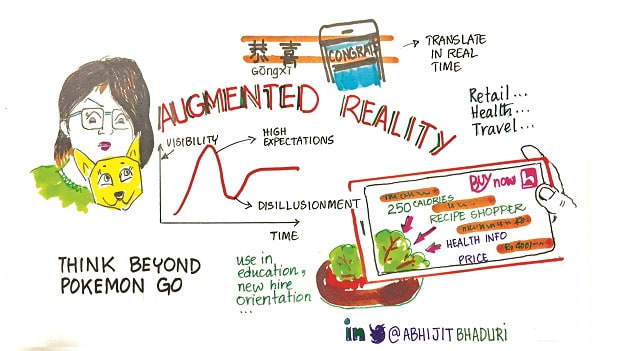The reality of Augmented Reality

The best of technology will often play hide and seek with us. There is the flash of a new technology that promises to change the world. Stories on social media trigger a wave of public interest. And this is what Gartner calls the first phase of the ‘Hype Cycle’. That in turn prompts venture capitalists (VCs) to fund startups working in the area. Companies make changes hoping to capture the market by being early movers.
Most of the early startups fail to get the prototype to be successful. VCs get impatient and demand returns. The startups beg for more time and go back to the drawing board with wisdom gleaned from their failures. The subsequent versions of the product show promise and the consumers who had walked away from the marketplace are back. Technology gathers traction and finds better applications. The technology in its final phase of democratization becomes like electricity. It becomes invisible and is taken for granted.
Augmented Reality going beyond Pokémon Go
Augmented Reality (AR) is in the early phase of the cycle. Simply put, Augmented Reality superimposes digital data and visuals as you look at the real world through your phone screen. In 2016, Pokémon Go took the world by storm. The cute Pokémon characters had to be collected by booty hunters. They did it by looking for digital images that could only be seen by pointing their phone in different directions at the real world. It was a craze. No surprise that it became the first game to reach a billion dollars. They did it all in six months.
Interactivity can drive engagement
AR apps are not new. Apps like Layar have been around since 2009. Layar allows a recipe printed in a supermarket flyer to become interactive. Once the information is embedded, it can make shopping an interactive experience. The customer can scan the recipe and select the number of people to cook for. The app will display the exact quantity of ingredients needed.
Imagine using AR to design the employee induction program. As the new joinees walk through the office, they can point to a building, know which departments are located there, the projects they are working on and even get to know the colleagues they are going to meet.
AR can also be used to train a geographically dispersed workforce on products and services. Snapchat has made every millennial comfortable with AR.
Technology in its final phase of democratization becomes like electricity. It becomes invisible and is taken for granted
Try before you buy
Inkhunter is an AR app that lets you try out a tattoo to see how it would look on you. You can click a photo of the digital tattoo on hand and seek the opinion of your friends to see if you should get the permanent version.
Imagine drawing a colorful bird on a piece of paper and then being able to watch it fly. That’s just what Quiver lets you do. Their mission is to produce educational content that supports learning in fun and stimulating ways. They want to supply brands looking to add digital flair to their marketing campaigns with exciting solutions.
While Pokémon Go may have been the best marketing campaign for AR, we are only scratching the surface
Better Health and Wealth
Doctors can leverage AR to access patient’s lab results and medical records in real time as they examine the patients. Surgeons can use it to go through checklists in the operation theatre before they start.
DHL has been using AR for introducing “vision picking” in their warehouses. Technology enables workers to find materials accurately wherever it may be stacked. The relevant package gets highlighted among the thousands of identical packages. DHL has claimed that it has led to a 25 percent improvement in productivity for the company. Imagine being able to point your phone at the office cafeteria and getting the nutritional value, price, calorie count etc. on your phone. Just click what you decide to buy and pay for it in one swipe of your finger.
Hardware, software and content
For AR to go mainstream, three pieces of the puzzle have to develop in tandem. The hardware must be robust. And battery life and processors must be able to withstand the heavy graphics and long usage. The biggest players are all putting their muscle to make it happen. Facebook has Oculus Rift. Microsoft has HoloLens. Google has Tango. Snapchat has its funky Spectacles. Samsung and HTC are making their own stuff. Hardware is getting better for sure. There are plenty of apps being built. Amikasa helps you configure your home and try out various pieces of furniture before you buy it.
But the apps have to be designed to go beyond gimmicky demonstrations to solving problems in the real world. Every app needs its own content to be able to engage the user. While Pokémon Go may have been the best marketing campaign for AR, we are only scratching the surface. The possibilities are endless. So don’t let your enthusiasm die down. The roller coaster has just started its journey.
















